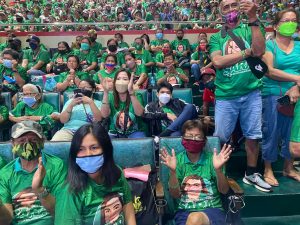Candidates in the ongoing Philippine presidential campaign have relied on certain colors as part of their political branding. By choosing a particular color, candidates aim to unify supporters and mobilize them to reach out to more voters. Their success or popularity in the campaign trail is made more visible through the colors they have chosen.
So far, Vice President Leni Robredo appears to be the most consistent in her use of color to promote her candidacy. She adopted the color pink as her symbol when she first announced her intent to run for president last October. This was welcomed by some of her supporters since she was previously linked to the “yellows” as a member of the Liberal Party, which headed the government from 2010 to 2016. Philippine President Rodrigo Duterte, who defeated the “yellow” candidate in 2016, often mocks critics for being part of the “dilawan” (yellows).
By adopting the color pink as her symbol, Robredo can focus on her campaign without the burden of being forced to defend the mixed legacy of the former ruling party. She continues to enjoy the support of the “yellows” and at the same time, has been able to make room for those belonging to other political forces.
This decision seemed to work in her favor since she has managed to get endorsements from opposition groups, sectoral coalitions, and local leaders in the months leading up to the start of the campaign period in February. The broad base of this political movement became evident over the past month when Robredo and her team succeeded in mobilizing tens of thousands of supporters in proclamation rallies across the country.
Despite lacking resources as an opposition candidate, Robredo was able to gather a record number of supporters in several cities which reflected her rising popularity among voters. In all these rallies, the color pink was prominently displayed on banners, flags, T-shirts, and other campaign paraphernalia. The emergence of the impressive “pink tide” in recent weeks could bring more votes, convert undecided local leaders, and inspire more people to campaign harder in order to defeat Robredo’s main rival, the son and namesake of a former dictator, Ferdinand “Bongbong” Marcos Jr.
The Marcos camp has also been consistent in adopting the colors red and green in the campaign. Presidential candidate Marcos wears red when appearing in public while his vice presidential candidate, Davao City Mayor Sara Duterte, wears green. Duterte is the president’s daughter but she is running under a different party. Marcos chose red probably because it’s the color that was used by his father, while Duterte’s use of green could be her way of asserting her own symbol in politics instead of simply benefiting from her popular name. The red and green colors dominate the proclamation rallies of the Marcos-Duterte tandem which has been successful too in mobilizing big crowds. Compared to the pink rallies, however, the Marcos-led rallies look smaller. There were also news reports claiming that some participants were paid to attend these events.
Other presidential candidates have their own colors, but unlike Robredo and Marcos, they have chosen other ways of consolidating public support instead of promoting the use of a particular colored symbol in the campaign. For example, Manila Mayor Isko Moreno Domagoso is associated with the color blue but he has not initiated a volunteer movement that actively promotes this color.
Colors in elections do not just refer to candidates but also to issues, trends, and political behavior. Black propaganda operations have been flagged by election watchdogs, while a media study showed that presidential candidates have been quiet about their green agenda, which disappointed environmentalists, and the pink phenomenon has triggered “red-tagging” statements from Robredo’s rivals. Senator Panfilo Lacson, a presidential candidate and former police chief, promoted the false accusation that some supporters and volunteers of Robredo are communist members. He also warned against a possible coalition government with the Communist Party although he failed to substantiate this allegation. He was called out for spreading this malicious spin to discredit his rival while endangering the lives of Robredo supporters. Red-tagging in the Philippine context often leads to violent consequences.
It is expected that these colors will continue to compete for dominance ahead of the elections scheduled for May 9. These colors are useful for candidates and they make the campaign activities more visually attractive, but they can be a disservice to voters who may think that a color is an adequate substitute for the type of campaigning that promotes political parties, their platforms, and the track record of their leaders.

































